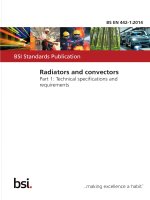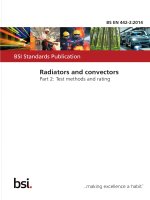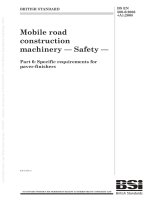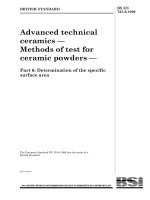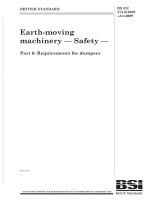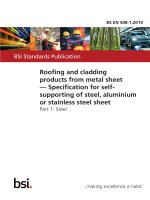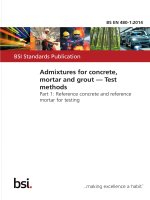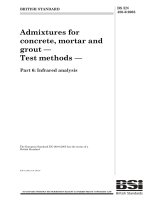Bsi bs en 13141 6 2014
Bạn đang xem bản rút gọn của tài liệu. Xem và tải ngay bản đầy đủ của tài liệu tại đây (1.32 MB, 32 trang )
BS EN 13141-6:2014
BSI Standards Publication
Ventilation for buildings
— Performance testing of
components/products for
residential ventilation
Part 6: Exhaust ventilation system packages
used in a single dwelling
BS EN 13141-6:2014
BRITISH STANDARD
National foreword
This British Standard is the UK implementation of EN 13141-6:2014.
It supersedes BS EN 13141-6:2004 which is withdrawn.
The UK participation in its preparation was entrusted to Technical
Committee RHE/2, Ventilation for buildings, heating and hot water
services.
A list of organizations represented on this committee can be
obtained on request to its secretary.
This publication does not purport to include all the necessary
provisions of a contract. Users are responsible for its correct
application.
© The British Standards Institution 2015. Published by BSI Standards
Limited 2015
ISBN 978 0 580 79750 7
ICS 91.140.30
Compliance with a British Standard cannot confer immunity from
legal obligations.
This British Standard was published under the authority of the
Standards Policy and Strategy Committee on 28 February 2015.
Amendments issued since publication
Date
Text affected
BS EN 13141-6:2014
EN 13141-6
EUROPEAN STANDARD
NORME EUROPÉENNE
EUROPÄISCHE NORM
December 2014
ICS 91.140.30
Supersedes EN 13141-6:2004
English Version
Ventilation for buildings - Performance testing of
components/products for residential ventilation - Part 6: Exhaust
ventilation system packages used in a single dwelling
Ventilation des bâtiments - Essais de performance des
composants/produits pour la ventilation des logements Partie 6: Kits pour systèmes de ventilation par extraction
pour le logement individuel
Lüftung von Gebäuden - Leistungsprüfung von
Bauteilen/Produkten für die Lüftung von Wohnungen - Teil
6: Baueinheiten für Abluftanlagen für eine einzelne
Wohnung
This European Standard was approved by CEN on 6 September 2014.
CEN members are bound to comply with the CEN/CENELEC Internal Regulations which stipulate the conditions for giving this European
Standard the status of a national standard without any alteration. Up-to-date lists and bibliographical references concerning such national
standards may be obtained on application to the CEN-CENELEC Management Centre or to any CEN member.
This European Standard exists in three official versions (English, French, German). A version in any other language made by translation
under the responsibility of a CEN member into its own language and notified to the CEN-CENELEC Management Centre has the same
status as the official versions.
CEN members are the national standards bodies of Austria, Belgium, Bulgaria, Croatia, Cyprus, Czech Republic, Denmark, Estonia,
Finland, Former Yugoslav Republic of Macedonia, France, Germany, Greece, Hungary, Iceland, Ireland, Italy, Latvia, Lithuania,
Luxembourg, Malta, Netherlands, Norway, Poland, Portugal, Romania, Slovakia, Slovenia, Spain, Sweden, Switzerland, Turkey and United
Kingdom.
EUROPEAN COMMITTEE FOR STANDARDIZATION
COMITÉ EUROPÉEN DE NORMALISATION
EUROPÄISCHES KOMITEE FÜR NORMUNG
CEN-CENELEC Management Centre: Avenue Marnix 17, B-1000 Brussels
© 2014 CEN
All rights of exploitation in any form and by any means reserved
worldwide for CEN national Members.
Ref. No. EN 13141-6:2014 E
BS EN 13141-6:2014
EN 13141-6:2014 (E)
Contents
Page
Foreword ..............................................................................................................................................................4
Introduction .........................................................................................................................................................6
1
Scope ......................................................................................................................................................8
2
Normative references ............................................................................................................................9
3
Terms and definitions ........................................................................................................................ 10
4
Symbols and abbreviations ............................................................................................................... 11
5
5.1
5.2
5.2.1
Performance testing of aerodynamic characteristics ..................................................................... 12
General ................................................................................................................................................. 12
Test installation and conditions ........................................................................................................ 13
Test configuration............................................................................................................................... 13
5.2.1.1 Test installation................................................................................................................................... 13
5.2.1.2 Maximum airflow test configuration ................................................................................................. 13
5.2.1.3 Minimum airflow test configuration .................................................................................................. 14
5.2.1.4 Boosted airflow test configuration ................................................................................................... 14
5.2.1.5
5.2.2
5.2.3
5.2.4
Energy efficiency test — reference configuration ........................................................................... 14
Installation of duct connecting roof/wall outlet terminal to the fan unit ....................................... 16
Installation of ducts connecting exhaust air terminal devices and fan unit................................. 16
Test conditions ................................................................................................................................... 17
5.2.4.1 Exhaust conditions ............................................................................................................................. 17
5.2.4.1.1
Normal conditions ....................................................................................................................... 17
5.2.4.1.2
Wind conditions .......................................................................................................................... 18
5.2.4.2 Temperature ........................................................................................................................................ 18
5.2.4.3 Electrical conditions ........................................................................................................................... 18
5.3
Test procedure .................................................................................................................................... 18
5.4
Presentation of results ....................................................................................................................... 18
6
Performance testing of external leakages ....................................................................................... 19
7
7.1
7.2
7.3
7.4
Performance testing of electrical power .......................................................................................... 20
General ................................................................................................................................................. 20
Method ................................................................................................................................................. 21
Analysis of results .............................................................................................................................. 21
Presentation of results ....................................................................................................................... 21
8
Performance testing of energy efficiency ........................................................................................ 21
9
9.1
9.2
9.2.1
9.2.2
9.2.3
9.3
9.3.1
9.3.2
Performance testing of acoustic characteristic .............................................................................. 22
General ................................................................................................................................................. 22
Determination of the sound power level of the exhaust air terminal devices or range hood .... 23
Test installation and conditions for exhaust air terminal devices ................................................ 23
Test installation and conditions for range hoods ........................................................................... 24
Test procedure .................................................................................................................................... 24
Determination of the sound power level of the fan unit ................................................................. 24
General — Noise radiated through the casing of the unit .............................................................. 24
Test installation and conditions ........................................................................................................ 24
2
BS EN 13141-6:2014
EN 13141-6:2014 (E)
9.3.3
9.4
Measurements ..................................................................................................................................... 24
Presentation of the results ................................................................................................................. 25
Annex A (informative) Example of compensating mounting for air flow measurement device ............... 26
Bibliography ...................................................................................................................................................... 27
3
BS EN 13141-6:2014
EN 13141-6:2014 (E)
Foreword
This document (EN 13141-6:2014) has been prepared by Technical Committee CEN/TC 156 “Ventilation for
buildings”, the secretariat of which is held by BSI.
This European Standard shall be given the status of a national standard, either by publication of an identical
text or by endorsement, at the latest by June 2015, and conflicting national standards shall be withdrawn at
the latest by June 2015.
Attention is drawn to the possibility that some of the elements of this document may be the subject of patent
rights. CEN [and/or CENELEC] shall not be held responsible for identifying any or all such patent rights.
This document supersedes EN 13141-6:2004.
In comparison to EN 13141-6:2004 the following changes have been made:
—
in Clause 3, introduction of the definition of: maximum and minimum air volume flows (qvmax and qvmin),
demand control ventilation (DCV), boosted air volume flow (qvboost), short duct and long duct and
reference configuration (for the energy efficiency calculation);
—
in 5.2.2, differentiation of the duct connecting the roof/wall outlet to the fan unit depending if the fan unit
outlet is situated on the top of the fan unit or if it is situated on a face of the fan unit;
—
modification of Figure 6 describing the types of long ducts and long branched ducts (it now explains how
to deal with long branched ducts on which there are more than 3 spigots);
—
modification of Table 1 for the presentation of the aerodynamic characteristics;
—
adding in Clause 6 of a procedure for the measurement of the external leakage;
—
adding of Table 2 giving a classification of the external leakage;
—
in Clause 7, specification of the test conditions for the measurement of the electrical power;
—
in Clause 8, adding of a paragraph defining the test conditions and the calculation for the obtaining of the
energy efficiency;
—
creation of Table 3 for the presentation of the power consumption results;
—
in Clause 9, specification of the acoustic test conditions;
—
in Annex A, modification and explanation of Figure A.1 representing an example of compensating
mounting for air flow measurement device.
EN 13141 consists of the following parts, under the general title Ventilation for buildings ― Performance
testing of components/products for residential ventilation:
—
Part 1: Externally and internally mounted air transfer devices
—
Part 2: Exhaust and supply air terminal devices
—
Part 3: Range hoods for residential use
—
Part 4: Fans used in residential ventilation systems
4
BS EN 13141-6:2014
EN 13141-6:2014 (E)
—
Part 5: Cowls and roof outlet terminal devices
—
Part 6: Exhaust ventilation system packages used in a single dwelling
—
Part 7: Performance testing of a mechanical supply and exhaust ventilation units (including heat recovery)
for mechanical ventilation systems intended for single family dwellings
—
Part 8: Performance testing of un-ducted mechanical supply and exhaust ventilation units (including heat
recovery) for mechanical ventilation systems intended for a single room
—
Part 9: Externally mounted humidity controlled air transfer device
—
Part 10: Humidity controlled extract air terminal device
—
Part 11: Positive pressure ventilation systems
According to the CEN-CENELEC Internal Regulations, the national standards organizations of the following
countries are bound to implement this European Standard: Austria, Belgium, Bulgaria, Croatia, Cyprus, Czech
Republic, Denmark, Estonia, Finland, Former Yugoslav Republic of Macedonia, France, Germany, Greece,
Hungary, Iceland, Ireland, Italy, Latvia, Lithuania, Luxembourg, Malta, Netherlands, Norway, Poland, Portugal,
Romania, Slovakia, Slovenia, Spain, Sweden, Switzerland, Turkey and the United Kingdom.
5
BS EN 13141-6:2014
EN 13141-6:2014 (E)
Introduction
This European Standard specifies test methods on ventilation system package and permits to avoid tests on
each component separately.
The performance characteristics of the components/products for residential ventilation are given in EN 13142,
[1].
The position of this European Standard in the field of standards for the mechanical building services is shown
in Figure 1.
6
BS EN 13141-6:2014
EN 13141-6:2014 (E)
Figure 1— Position of EN 13141-6 in the field of the mechanical building services
7
BS EN 13141-6:2014
EN 13141-6:2014 (E)
1
Scope
This European Standard specifies laboratory methods for measuring the aerodynamic and acoustic
performance characteristics and energy consumption of assembled exhaust ventilation system packages for a
single dwelling. If a component of the package is not physically linked to the others (e.g. air inlets), then it is
assumed to have been tested according to the test method related to this component. An example of a typical
exhaust package is given in Figure 2.
The object of this European Standard is to provide tested characteristics for a ventilation system package in
worst case conditions. It is assumed that better values are achieved on site when the ventilation system
package is installed in accordance with the manufacturer's instruction and within the limits of the test
conditions given in this standard.
Safety requirements are given in EN 60335-2-80.
Key
1
fan unit
7
duct for extract air from 6
2
roof/wall outlet
8
exhaust air terminal device (toilets)
3
duct for roof/wall outlet
9
duct for extract air from 8
4
static extraction range hood or exhaust
10
sound attenuators
air terminal device (kitchen)
11
controls
5
duct for range hood
12
set of air inlets
6
exhaust air terminal device (bathroom)
Figure 2 — Example of system package: exhaust ventilation system package
8
BS EN 13141-6:2014
EN 13141-6:2014 (E)
NOTE
In Figure 2, ducts, outlets, fan, exhaust air terminal devices, sound attenuators, etc. are presented assembled
but they are normally sold disassembled in a single package.
2
Normative references
The following documents, in whole or in part, are normatively referenced in this document and are
indispensable for its application. For dated references, only the edition cited applies. For undated references,
the latest edition of the referenced document (including any amendments) applies.
EN 12792:2003, Ventilation for buildings - Symbols, terminology and graphical symbols
EN 13141-4, Ventilation for buildings - Performance testing of components/products for residential ventilation Part 4: Fans used in residential ventilation systems
EN 13141-7:2010, Ventilation for buildings - Performance testing of components/products for residential
ventilation - Part 7: Performance testing of a mechanical supply and exhaust ventilation units (including heat
recovery) for mechanical ventilation systems intended for single family dwellings
EN 60704-2-13, Household and similar electrical appliances - Test code for the determination of airborne
acoustical noise - Part 2-13: Particular requirements for range hoods
EN ISO 3741, Acoustics - Determination of sound power levels and sound energy levels of noise sources
using sound pressure - Precision methods for reverberation test rooms (ISO 3741)
EN ISO 3743-1, Acoustics - Determination of sound power levels and sound energy levels of noise sources
using sound pressure - Engineering methods for small movable sources in reverberant fields - Part 1:
Comparison method for a hard-walled test room (ISO 3743-1)
EN ISO 3743-2, Acoustics - Determination of sound power levels of noise sources using sound pressure Engineering methods for small, movable sources in reverberant fields - Part 2: Methods for special
reverberation test rooms (ISO 3743-2)
EN ISO 3744, Acoustics - Determination of sound power levels and sound energy levels of noise sources
using sound pressure - Engineering methods for an essentially free field over a reflecting plane (ISO 3744)
EN ISO 3745, Acoustics - Determination of sound power levels and sound energy levels of noise sources
using sound pressure - Precision methods for anechoic rooms and hemi-anechoic rooms (ISO 3745)
EN ISO 5167-1, Measurement of fluid flow by means of pressure differential devices inserted in circular crosssection conduits running full - Part 1: General principles and requirements (ISO 5167-1)
EN ISO 5167-2, Measurement of fluid flow by means of pressure differential devices inserted in circular crosssection conduits running full - Part 2: Orifice plates (ISO 5167-2)
EN ISO 5167-3, Measurement of fluid flow by means of pressure differential devices inserted in circular crosssection conduits running full - Part 3: Nozzles and Venturi nozzles (ISO 5167-3)
EN ISO 5167-4, Measurement of fluid flow by means of pressure differential devices inserted in circular crosssection conduits running full - Part 4: Venturi tubes (ISO 5167-4)
EN ISO 5801, Industrial fans - Performance testing using standardized airways (ISO 5801)
EN ISO 9614-1, Acoustics - Determination of sound power levels of noise sources using sound intensity - Part
1: Measurement at discrete points (ISO 9614-1)
9
BS EN 13141-6:2014
EN 13141-6:2014 (E)
EN ISO 9614-2, Acoustics - Determination of sound power levels of noise sources using sound intensity - Part
2: Measurement by scanning (ISO 9614-2)
3
Terms and definitions
For the purposes of this document, the terms and definitions given in EN 12792:2003 and the following apply.
3.1
ventilation system package (for a single dwelling)
combination of compatible components designed as a single product to obtain a full residential ventilation
system when installed as specified by the manufacturer
Note 1 to entry
It may exclude ducts and minor parts such as tapes, sealants and screws.
3.2
exhaust ventilation system package
system package comprising all components necessary to realize at least the exhaust part of a ventilation
system in a dwelling
Note 1 to entry
The following components may be part of the package: fan unit, roof/wall outlet, ducts (for roof/wall
outlet, for exhaust air terminal devices), exhaust air terminal devices, range hood, controls, sound attenuators, set of
externally mounted air transfer devices.
3.3
test-voltage
voltage to be used for supplying the components during the testing
3.4
fan unit
casing incorporating a fan and provided with spigots
[SOURCE: EN 12792:2003, definition 164]
3.5
maximum air volume flow
qvmax
maximum ventilation air volume flow rate measured in the worst case conditions and corresponding to the
operating range declared by the manufacturer, given for standard air conditions
[SOURCE: EN 12792:2003]
3.6
minimum air volume flow
qvmin
minimum ventilation air volume flow rate measured in DCV packages in the worst case conditions and
corresponding to the operating range declared by the manufacturer, given for standard air conditions
[SOURCE: EN 12792:2003]
10
BS EN 13141-6:2014
EN 13141-6:2014 (E)
3.7
demand controlled ventilation
DCV
method providing automatic control of air volume flow of the ventilation system dependent upon the needs of
air change rates (occupancy, pollution loads, etc.) using a suitable sensor and without user intervention i.e.
automatic
3.8
boosted air volume flow
qvboost
air volume flow rate dedicated to the ventilation of the dwelling and to the punctual (e.g. on a very short time)
removal of localized pollutants
Note 1 to entry
The boost function can be used in the kitchen when cooking, in the bathroom during the shower, etc.
3.9
reference configuration
configuration defined for the energy efficiency calculation
3.10
short duct
duct made of one elbow (where R = D) and whose length is less than or equal to 1,5 m
3.11
long duct
duct made of three elbows and whose total length is at least equal to 6,5 m
3.12
collecting duct
duct, in a multi family dwelling, that collects the exhaust of several exhaust systems
4
Symbols and abbreviations
For the purposes of this document, the symbols and abbreviations given in EN 12792:2003 and the following
apply.
Symbol
Designation
Unit
ATD
Air terminal Device
—
DCV
Demand Control Ventilation
—
qv
Total air volume flow rate
m /s
qvt
Total air volume flow rate measured downstream the fan
m /s
qve
External leakage air volume flow rate
m /s
qvmin
Minimum ventilation air volume flow rate measured in the worst case conditions, m /s
with the minimum number of spigots and with the ATD at their minimum setting
qvmax
Maximum ventilation air volume flow rate measured in the worst case conditions, m /s
with the maximum number of spigots and with the ATD at their maximum setting
qvboost
Boosted ventilation air volume flow rate measured in the worst case conditions m /s
3
3
3
3
3
3
11
BS EN 13141-6:2014
EN 13141-6:2014 (E)
and with the ATD not contributing to the boost function at their minimum setting
3
qvminref
Minimum ventilation air volume flow rate in the reference configuration with the m /s
ATD at their minimum setting
qvmaxref
Maximum ventilation air volume flow rate in the reference configuration with the m /s
ATD at their maximum setting
qvboostref
Boosted ventilation air volume flow rate in the reference configuration with the m /s
ATD not contributing to the boost function at their minimum setting
Fmin
Occurrence frequency for qvminref
—
Fmax
Occurrence frequency for qvmaxref
—
Fboost
Occurrence frequency for qvboostref
—
PE
Electric power input
W
PEminref
Electric power input at qvminref
W
PEmaxref
Electric power input at qvmaxref
W
PEboostref
Electric power input at qvboostref
W
LW
Sound power level
dB
LWA
A-weighted sound power level
dB
SPIw
Weighted specific power input part load
W/m /s
5
3
3
3
Performance testing of aerodynamic characteristics
5.1 General
The following aerodynamic characteristics shall be determined:
—
air volume flow rate qv for each exhaust air terminal device;
—
total air volume flow rate qvt measured downstream to the fan.
When a range hood is incorporated into the system, the total air volume flow rate is the sum of the exhaust air
terminal devices and range hood air flow rates.
When the ventilation system package allows a range of air volume flow rates, the rate being varied by means
of any control device, the aerodynamic characteristics shall be determined for both minimum and maximum
levels and any other intermediate levels that may be requested by the manufacturer.
The air volume flow rates shall be determined for the conventional configurations specified in 5.2, giving the
least favourable extract conditions for aerodynamics.
12
BS EN 13141-6:2014
EN 13141-6:2014 (E)
5.2 Test installation and conditions
5.2.1
Test configuration
5.2.1.1
Test installation
Tests shall be carried out with all the components which are directly linked, assembled in the configuration
specified in Figure 3 according to the information provided for the package.
Key
1
fan unit
4
exhaust air terminal device
2
long duct
5
flow meter
3
long branched duct
6
electrical power source
NOTE
One spigot is used for a branched duct (e.g. 2 spigots, 3 extractions).
Figure 3 — Example of test installation
5.2.1.2
Maximum airflow test configuration
A package is evaluated in the worst case conditions for the maximum setting of the intended use if:
—
the maximum number of spigots and the maximum number of exhaust air terminal devices are used; and
—
only long ducts and long branched ducts are connected to the fan unit.
The air terminal devices shall be set to their maximum opening. In the case, there is more than one air
terminal device connected to one spigot, the air terminal device allowing the highest air volume flow rate shall
be connected to the longest duct.
13
BS EN 13141-6:2014
EN 13141-6:2014 (E)
When automatic control devices are supplied as part of the system, the test shall be carried out with the air
terminal devices manually adjusted to the maximum required position.
In case there is a boost function, qvmax doesn’t take into account the boosted air volume flow rate.
5.2.1.3
Minimum airflow test configuration
A package is evaluated in the worst case conditions for the minimum setting of the intended use if:
—
the minimum number of air terminal devices is used; and
—
if only long ducts and long branched ducts are connected to the fan unit.
At least, the following air terminal devices shall be connected to the fan unit: one for the kitchen and one for
the bathroom. The air terminal devices shall be set, according to the manufacturer instructions, to obtain the
minimum air volume flow rate. When automatic control devices are supplied as part of the system, the test
shall be carried out with the air terminal devices manually adjusted to the minimum required position.
5.2.1.4
Boosted airflow test configuration
The boosted air volume flow rate shall be measured in the worst case conditions if only long ducts and long
branched ducts are connected to the fan unit.
The air terminal devices contributing to the boost function shall be set at their boosted setting and the air
terminal devices not contributing to the boosted airflow shall be set, according to the manufacturer
instructions, to obtain the minimum airflow. When automatic control devices are supplied as part of the
system, the test shall be carried out with the air terminal devices that don’t contribute to the boosted airflow
manually adjusted to the minimum required position.
5.2.1.5
Energy efficiency test — reference configuration
The configuration for this test is intended to represent the setting of the fan unit and the configuration of
spigots and air terminal devices typical of an average dwelling. Only long ducts or long branched ducts are
connected to the fan unit.
When automatic control devices are supplied as part of the system, the air volume flow rate extracted from the
dwelling for reference configuration can vary from a minimum (qvminref) to a maximum (qvmaxref) value with the
possibility of a boosted value (qvboostref) as shown in Figure 4.
When the system does not include automatic control devices, there is only one reference air volume flow rate
with the possibility of a boosted value (qvboostref) as shown in Figure 5. In this case qvminref equals to a qvmaxref.
qvmaxref is defined as follows: air volume flow rate measured with a number of spigots and air terminal devices
adjusted to achieve 70 % of qvmax or a value of air volume flow rate immediately superior to 70 % of qvmax.
When automatic control devices are supplied as part of the system, the test shall be carried out with the air
terminal devices manually adjusted to the maximum required position.
qvminref is measured in the reference configuration with the air terminal devices at their minimum setting. When
automatic control devices are supplied as part of the system, the test shall be carried out with the air terminal
devices manually adjusted to the minimum required position. The same number of spigots and air terminal
devices than by qvmaxref shall be used.
qvboostref is measured in the reference configuration with the air terminal devices that don’t contribute to the
boost function set, according to the manufacturer instructions, to obtain the minimum air volume flow rate.
When automatic control devices are supplied as part of the system, the air terminal devices not contributing to
the boost function shall be manually adjusted to the minimum required position.
14
BS EN 13141-6:2014
EN 13141-6:2014 (E)
The maximum number of spigots shall be used to obtain qvmaxref. At least the following air terminal devices
shall be connected to the fan unit: one for the kitchen, one for the bathroom and one for the toilets. qvmaxref
shall be obtained by choosing a combination of air terminal devices among those used for qvmax.
Key
1
total flow rate qv
2
fan unit settings
boost
Figure 4 — Example for the choice of the reference configuration for systems with automatic control
devices
15
BS EN 13141-6:2014
EN 13141-6:2014 (E)
Key
1
total flow rate qv
2
fan unit settings
boost
Figure 5 — Example for the choice of the reference configuration for systems without automatic
control devices
5.2.2
Installation of duct connecting roof/wall outlet terminal to the fan unit
If the system exhausts the air directly to outside, the exhaust fan unit shall be connected to the roof/wall outlet
terminal by the following ducting:
—
if the fan unit outlet is located on the top of the fan unit (and the extract spigots on the faces): straight
duct of 2 m long (see Figure 3);
—
if the fan unit outlet is located on a face of the fan unit (as well as the extract spigots): straight duct of
0,5 m long + 90° elbow + straight duct of 2 m long.
NOTE
vertical).
These ducting allow to have the same mounting whichever position of the extract spigot (horizontal or
When the system exhausts the air via a collecting duct, the fan exhaust shall be connected by a straight duct
of 2 m long to a device which can vary the pressure loss.
5.2.3
Installation of ducts connecting exhaust air terminal devices and fan unit
All exhaust air terminal devices shall be connected to the fan unit, using the maximum number of spigots
specified by the manufacturer/supplier.
The straight duct lengths specified by the manufacturer shall be at least equal to those indicated in Figure 6 a)
and Figure 6 b).
The long branched ducts are as follows:
—
16
if one exhaust is used then it is called number 1 according to Figure 6 b);
BS EN 13141-6:2014
EN 13141-6:2014 (E)
—
if two exhausts are used then they are called number 1 and number 2 according to Figure 6 b);
—
etc.
a) long duct
b) long branched duct
Key
d
d ≥ 1,5 m
L
L = min (4,5 m ; n x d)
Figure 6 — Types of ducts for connection of exhaust air terminal devices to the fan unit in
aerodynamic testing
Duct configurations shall be made using the components provided or specified by the manufacturer or
supplier.
When flexible ducts are provided or specified, they shall be extended to 90 % of their maximum length and
shall be supported to prevent sagging and to maintain the specified elbow radius.
The elbow may be realised by the duct itself placed in an appropriate guide.
When a range hood is part of the package, it shall be placed at least 1 m above floor.
Other exhaust air terminal devices may be left on the ground provided a correct orientation is provided and
they are not facing the ground.
5.2.4
Test conditions
5.2.4.1
5.2.4.1.1
Exhaust conditions
Normal conditions
The test shall be conducted under the following exhaust conditions:
—
Where the fan exhaust is connected to roof/wall outlet, the difference between the pressure upstream of
the exhaust air terminal devices and the pressure downstream the roof/wall outlet shall be (0 ± 2) Pa.
NOTE
This requirement is deemed to be satisfied when the exhaust air terminal devices and the roof / wall outlet are
in the same room.
—
Where the fan exhaust is connected to a collecting duct, 3 pressure differences at the exhaust, defined by
the manufacturer, shall be applied, including 0 Pa.
17
BS EN 13141-6:2014
EN 13141-6:2014 (E)
5.2.4.1.2
Wind conditions
To test the wind effect, a counter-pressure of + 20 Pa at the exhaust shall be added:
—
to the normal conditions for connection to roof/wall outlet;
—
to the highest value for connection to a collecting duct.
Only the total exhaust air volume flow rate qvt at the fan unit outlet shall be measured.
5.2.4.2
Temperature
The temperature of the test room shall be maintained at 20 °C ± 5 °C. During the test, this temperature shall
not vary by more than ± 2 °C.
5.2.4.3
Electrical conditions
When a single value is assigned by the manufacturer as rated voltage, this shall be the test voltage. Where a
voltage range is assigned to the product by the manufacturer that includes 230 VAC, the test voltage shall be
230 VAC.
This voltage shall be maintained to ± 1 % throughout the testing.
5.3 Test procedure
Air flow measurements, shall be in accordance with EN ISO 5167-1, EN ISO 5167-2, EN ISO 5167-3 and EN
ISO 5167-4. Other measurement devices may be used if allowing measurements of equivalent uncertainty.
The measurement device pressure drop shall be compensated so as to restore the "normal condition"
specified in 5.2.4.1.1 (see Annex A for an example of compensating mounting).
The volume flow rate shall be measured with an uncertainty lower than:
(
)(
0,3 + 0,03 × measured value l ⋅ s
−1
)
5.4 Presentation of results
The test configurations and conditions shall be clearly described in a report.
Aerodynamics characteristics shall be presented in accordance with Table 1.
18
BS EN 13141-6:2014
EN 13141-6:2014 (E)
Table 1 — Presentation of the aerodynamic characteristics
Air flow rate qv
Extract
condition
Minimum
Maximum
airflow test
airflow test
configuration configuration
Maximum
boosted
airflow test
configuration
Other
control
setting
Minimum
airflow
reference
configuration
b
Boosted
Maximum
airflow
airflow
reference
reference
c
configuration configuration
Configuratio
n
Kitchen
Bath 1
Toilet 1
Bath 2
Toilet 2
etc.
Fan unit
a
a
Total air volume flow rate, qvt, measured downstream the fan.
b
In case of automatic control devices.
c
In case of the presence of a boosted function on the system.
6
Performance testing of external leakages
The external leakage test shall be carried out by connecting an adjustable fan to the exhaust air side of the
tested fan unit as shown in Figure 7.
The static pressure tapping is located on a blanking off plate and the tap is connected to a pressure
measuring instrument. The external leakage flow rates at under pressure in the casing are established with
suitable air flow measuring equipment.
The accuracy of the measured values shall be kept within ± 5 % for the flow rates and ± 3 % for the static
pressures of the casing.
19
BS EN 13141-6:2014
EN 13141-6:2014 (E)
Key
1
adjustable fan
2
air flow measuring equipment
3
fan unit
4
static pressure measuring equipment
Figure 7 — External leakage test configuration
Pressure method applies to classify leakages by using Table 2.
Table 2 — Leakage classification — Pressure method
Class
External leakage
(at 250 Pa)
%
A1
≤2
A2
≤5
A3
≤ 10
not classified
> 10
The external leakage shall be measured according to EN 13141-7:2010, Annex B.
The external leakage air volume flow qve at under pressure of 250 Pa, according to Table 2, shall be reported
as such and also compared to the maximum air volume flow qvmax of the unit as a percentage.
At least three different measurement points evenly distributed shall be made between 100 Pa and 300 Pa,
and reported by means of a curve.
During the pressurisation tests for external leakages, the fan unit under test shall be switched off.
7
Performance testing of electrical power
7.1 General
The electric power input PE of a unit shall be measured in several modes when possible.
20
BS EN 13141-6:2014
EN 13141-6:2014 (E)
In active mode, the unit is connected to the main power source and is providing the intended service. This
means the controls system is operating and the unit provides suitable ventilation rates according to the control
strategy.
The electric power input PE shall be measured during each test described in 5.2.1.2, 5.2.1.3, 5.2.1.4 and
5.2.1.5 and shall be reported as in Table 3.
Table 3 — Presentation of the power consumptions
Minimum
Maximum
airflow test
airflow test
configuration configuration
Maximum
boosted
airflow test
configuration
Extract
condition
Minimum
airflow
Maximum
airflow
Boosted
airflow
reference
reference
reference
configuration configuration configuration
a
b
PE
a
b
In case of automatic control devices.
In case of the presence of a boosted function on the system.
The electric power input PE shall be measured according to EN 13141-4.
If the system includes a mode in which the fans are not operating and control components are still active, then
the electric power input shall also be measured in this mode.
If the system can be switched off manually or with any remote control system and if the end of this mode is
also given by a manual action, the electric power input shall be measured with the high voltage in operation.
7.2 Method
The electrical power of the ventilation system package shall be determined according to EN ISO 5801 for
same speed/setting of the fan as assessed in 5.1.
7.3 Analysis of results
The electrical power input determined in 7.2 shall be used to calculate the energy consumption per unit of total
air flow rate.
7.4 Presentation of results
The results shall be presented in a graph (electrical power per unit of total air flow rate versus total air flow
rate).
8
Performance testing of energy efficiency
For energy efficiency characterisation, measurements of the power supply shall be realized as specified in
Clause 7 at minimum (qvminref), maximum (qvmaxref) and boosted (qvboostref) air volume flows of the reference
configuration if there is more than one speed (see Table 4). The test conditions are the same as in 5.2.4.
The weighted specific power input part load, SPIw shall be calculated according to the formula below with the
parameters defined in Table 4:
21
BS EN 13141-6:2014
EN 13141-6:2014 (E)
SPIw =
Fmin × PE minref + Fmax × PE maxref + Fboost × PE boostref
Fmin × q vminref + Fmax × q vmaxref + Fboost × q vboostref
where
PE minref
is the electrical power measured at q vminref , in W;
PE maxref
is the electrical power measured at q vmaxref , in W;
PE boostref
is the electrical power measured at q vboostref , in W;
q vminref
is the sum of the air volume flow rates of all the air terminal devices at their minimum setting,
3
in m /s;
q vmaxref
is the sum of the air volume flow rates of all the air terminal devices at their maximum setting,
3
in m /s;
q vboostref
is the sum of the air volume flow rates of all the air terminal devices at their boost setting, in
3
m /s;
Fmin , Fmax , Fboost
are occurrence frequencies.
Table 4 — Values of occurrence frequencies Fmin ,
Fmax and Fboost for part load weighting
Fmin
Fmax
Fboost a
On/off
―
1
―
Fixed — 1 speed with boost function
―
0,96
0,04
Fixed — 1 speed without boost function
―
1
―
Fixed — 2 or 3 speeds with boost function
0,22
0,74
0,04
Fixed — 2 or 3 speeds without boost function
0,23
0,77
―
0,5
0,46
0,04
0,52
0,48
―
Application
DCV with boost function
a
DCV without boost function
a
a The values of occurrence frequencies for DCV systems have been established by
making a linear extrapolation on one single power curve.
9
Performance testing of acoustic characteristic
9.1 General
The following acoustic characteristics can be determined:
—
sound power level emitted by each type of exhaust ATD;
—
sound power level emitted by the casing.
The air flows shall be determined for the conventional configuration specified in 9.2.1, the short duct giving the
most unfavourable extract condition for acoustics.
The following acoustic data shall be included in the report:
—
22
sound power level LW ;
BS EN 13141-6:2014
EN 13141-6:2014 (E)
—
A-weighted sound power level LWA;
—
sound power levels in octave bands between 125 Hz and 8 000 Hz.
9.2 Determination of the sound power level of the exhaust air terminal devices or range hood
9.2.1
Test installation and conditions for exhaust air terminal devices
The exhaust air terminal device to be tested shall be connected to the fan unit through a "short duct" as shown
in Figure 8.
Key
1
elbow
2
extract air
Figure 8 — Type of ducts for connection of exhaust air terminal devices to the fan unit in acoustic
testing
The straight duct lengths are specified by the manufacturer and are at maximum equal to those indicated
above.
The duct is 1,5 m long with a 90° elbow at the middle (between 40 % and 60 % of its length). The duct shall be
stretched at approximately 90 % of its maximum length.
Acoustic measurements shall be made under the following conditions:
—
the maximum number of spigots as specified by the manufacturer shall be used;
—
the number of exhaust air terminal devices connected shall be as specified by the manufacturer;
—
the duct between the exhaust air terminal device under test and the fan unit shall be as specified by the
manufacturer;
—
the ducts for the other exhaust air terminal devices shall be "short ducts", and outside the measurement
room in which is the exhaust air terminal device only;
—
the duct connection between roof/wall outlet and the fan unit shall be as specified in 5.2.2;
—
where a single value is assigned by the manufacturer as rated voltage, this shall be the test voltage.
Where a voltage range is assigned to the product by the manufacturer that includes 230 VAC, the test
voltage shall be 230 VAC. This voltage shall be maintained to ± 1 % throughout the testing;
—
test shall be carried out under test voltage;
23


